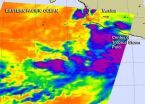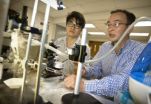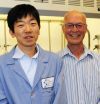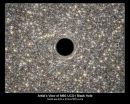(Press-News.org) Buffers that guard against damage to the ends of chromosomes could hold the key to a better understanding of malignant melanoma – the deadliest form of skin cancer – according to new research from the University of Leeds.
The study has uncovered an important new genetic risk factor for melanoma.
It is well known that pigmentation and mole count are the strongest indicators of those most at risk of developing melanoma. For example, paler people should take more care in the sun, as they burn more easily.
It now appears that another risk factor is the length of telomeres, regions at the end of every chromosome that buffer and protect against DNA deterioration and damage when cells are replicated.
Dr Mark Iles, of the School of Medicine at the University of Leeds, who led the research team, said: "Telomeres have been described as being like the plastic tips on shoelaces that protect the shoelace from fraying, just as telomeres protect chromosomes from degrading or fusing to one another.
"For the first time, we have established that the genes controlling the length of these telomeres play a part in the risk of developing melanoma."
He continued: "More research is needed to better understand the relationship between melanoma and telomeres, but learning more about how an individual's genetic telomere profile influences their risk developing melanoma may help us. It will improve our understanding of melanoma biology and gives us a target towards developing potential treatments as well as potentially helping shape advice on what behavioural changes people might make."
The research team created a score representing genetically-determined telomere length, based on all the established telomere associated genes and found that this score was associated with melanoma risk. The one in four people predicted to have the longest telomeres are at 30% increased risk of developing melanoma compared to those one in four predicted to have the shortest telomeres.
Dr Kat Arney, science information manager at Cancer Research UK, which funded the research, said: "This kind of research is vital if we're to understand how people's genetic makeup influences their risk of developing cancer. There's a lot we still don't understand about how telomere length is linked to cancer risk, but this new study is a step forward in unravelling the secrets of these unusual DNA structures."
Malignant melanoma is the fifth most common cancer in the UK with around 12,800 new cases and around 2,200 deaths each year.
The research will be published in the Journal of the National Cancer Institute.
INFORMATION:
Further information
Dr Mark Iles is available for interview. Contact Ben Jones in the University of Leeds press office on +44 (0)113 343 8059 or email B.P.Jones@leeds.ac.uk
A copy of the research paper, "The effect on melanoma risk of genes previously associated with telomere length", by Iles et al, is available from the Press Office.
Cancer Research UK
Cancer Research UK is the world's leading cancer charity dedicated to saving lives through research.
Cancer Research UK's pioneering work into the prevention, diagnosis and treatment of cancer has helped save millions of lives.
Cancer Research UK receives no government funding for its life-saving research. Every step it makes towards beating cancer relies on every pound donated.
Cancer Research UK has been at the heart of the progress that has already seen survival rates in the UK double in the last forty years.
Cancer Research UK supports research into all aspects of cancer through the work of over 4,000 scientists, doctors and nurses.
Together with its partners and supporters, Cancer Research UK's vision is to bring forward the day when all cancers are cured.
For further information about Cancer Research UK's work or to find out how to support the charity, please call 0300 123 1022 or visit http://www.cancerresearchuk.org. Follow us on Twitter and Facebook
University of Leeds
The University of Leeds is one of the largest higher education institutions in the UK and a member of the Russell Group of research-intensive universities. http://www.leeds.ac.uk
Chromosome buffers hold key to better melanoma understanding
2014-09-17
ELSE PRESS RELEASES FROM THIS DATE:
NASA sees Tropical Storm Polo intensifying
2014-09-17
Tropical storm warnings now issued for a portion of the Southwestern coast of Mexico as Polo continues to strengthen. Infrared imagery from NASA's Aqua satellite showed powerful thunderstorms around the center of the storm.
A Tropical Storm Warning is in force for the southwest coast of Mexico from Punta San Telmo to Playa Perula. A Tropical Storm Watch is in force from Punta San Telmo to Zihuatanejo and from Playa Perula to Cabo Corrientes. Rainfall totals of 5 to 10, locally up to 15 inches, can be expected over coastal areas of Michoacan, Colima and Jalisco states ...
NASA sees Hurricane Edouard far from US, but creating rough surf
2014-09-17
Although NASA's Aqua satellite showed that Hurricane Edouard is far from U.S. soil, it is powerful enough that it is creating dangerous swells along the U.S. East Coast.
On Sept. 17, the National Hurricane Center noted "Swells from Edouard will affect portions of the east coast of the United States north of Florida beginning today. These swells will likely cause life-threatening rip current conditions along most of the United States east coast for the next couple of days."
When NASA's Aqua satellite passed over Hurricane Edouard on Sept. 16 the MODIS instrument captured ...
Shorebird's beak inspires UT Arlington research on water collection
2014-09-17
A UT Arlington engineering professor and his doctoral student have designed a device based on a shorebird's beak that can accumulate water collected from fog and dew.
The device could provide water in drought-stricken areas of the world or deserts around the globe.
Cheng Luo, professor in the Mechanical & Aerospace Engineering Department, and Xin Heng, PhD candidate in the same College of Engineering department, published "Bioinspired Plate-Based Fog Collectors" in the Aug. 25 edition of ACS' (American Chemical Society) Applied Materials & Interfaces journal. ACS also ...
Scripps Research Institute chemists modify antibiotic to vanquish resistant bacteria
2014-09-17
LA JOLLA, CA—September 17, 2014—Scientists at The Scripps Research Institute (TSRI) have devised a new antibiotic based on vancomycin that is powerfully effective against vancomycin-resistant strains of MRSA and other disease-causing bacteria.
The new vancomycin analog appears to have not one but two distinct mechanisms of anti-microbial action, against which bacteria probably cannot evolve resistance quickly.
"This is the prototype of analogues that once introduced will still be in clinical use a generation or maybe even two generations from now," said Dale L. Boger, ...
Habitual Facebook users more likely to be caught in phishing scams
2014-09-17
Washington, DC (September 17, 2014) – Receiving an email that claims you are the recipient of a large sum of money from an unknown deceased relative immediately raises a red flag. These email scams are often trashed or filtered through spam folders. But what about on social networks where there is no filter? Where people can learn about your personal life with a few clicks? A recent study published in the Journal of Computer-Mediated Communication by a researcher at the University at Buffalo – State University of New York found that people who habitually use Facebook were ...
Failed Medicare payments law remains relevant
2014-09-17
PROVIDENCE, R.I. [Brown University] — As Congress adjourns this month for the November elections, one of the killed bills senators will step over on their way out the chamber door will be the Sustainable Growth Rate (SGR) Repeal and Medicare Provider Payment Modernization Act of 2014. In a new commentary in the journal JAMA Surgery, Dr. Eli Adashi recounts what he and other advocates saw as the merits of the originally bipartisan bill. The perennial trouble with how Medicare pays doctors will return for the next Congress, Adashi said, and broader trends in health care practice ...
A massive black hole has been found at the center of an ultra-compact galaxy
2014-09-17
A team of researchers, including an astronomer from Michigan State University, has discovered a huge black hole at the center of an ultra-compact galaxy – the smallest galaxy known to contain one.
The galaxy, known as M60-UCD1, was discovered last year by a team led by Jay Strader, MSU assistant professor of physics and astronomy. Strader was a member of the team that found the black hole.
The findings are detailed in the recent edition of the journal Nature.
The finding suggests that other ultra-compact galaxies also may contain massive black holes. And that those ...
New non-invasive technique could revolutionize the imaging of metastatic cancer
2014-09-17
Bioluminescence, nanoparticles, gene manipulation – these sound like the ideas of a science fiction writer, but, in fact, they are components of an exciting new approach to imaging local and metastatic tumors. In preclinical animal models of metastatic prostate cancer, scientists at Virginia Commonwealth University Massey Cancer Center, VCU Institute of Molecular Medicine and Johns Hopkins Medical Institutions have provided proof-of-principle of a new molecular imaging approach that could revolutionize doctors' ability to see tumors that have metastasized to other sites ...
Hubble helps find smallest known galaxy containing a supermassive black hole
2014-09-17
Astronomers using data from NASA's Hubble Space Telescope and ground observation have found an unlikely object in an improbable place -- a monster black hole lurking inside one of the tiniest galaxies ever known.
The black hole is five times the mass of the one at the center of our Milky Way galaxy. It is inside one of the densest galaxies known to date -- the M60-UCD1 dwarf galaxy that crams 140 million stars within a diameter of about 300 light-years, which is only 1/500th of our galaxy's diameter.
If you lived inside this dwarf galaxy, the night sky would dazzle ...
Space: The final frontier… open to the public
2014-09-17
Historically, spaceflight has been reserved for the very healthy. Astronauts are selected for their ability to meet the highest physical and psychological standards to prepare them for any unknown challenges. However, with the advent of commercial spaceflight, average people can now fly for enjoyment. The aerospace medicine community has had very little information about what medical conditions or diseases should be considered particularly risky in the spaceflight environment, as most medical conditions have never been studied for risk in space — until now.
The aerospace ...





